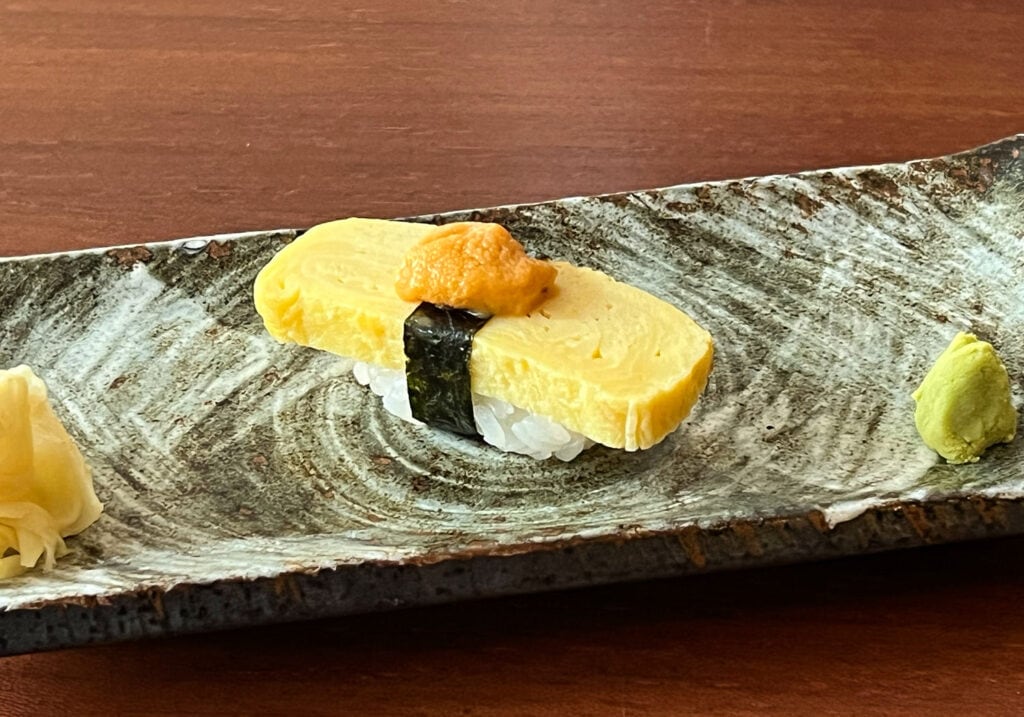In Japan, Uni, as sea urchin is called there, is a sought-after delicacy. Thanks to an incomparable spicy flavor and creamy texture, it is also becoming increasingly popular outside Japan. Whether you enjoy Uni as sushi or sashimi, the diverse flavors of this special delicacy will immediately captivate you.
What is Uni?
Uni is the Japanese term for sea urchins that are made into delicious dishes.
The sea urchins, which at first glance do not look very appetizing, hide their culinary secret inside. For there are the gonads, a kind of reproductive glands, which are very tasty. Since each sea urchin has only five gonads, Uni is a rather rare specialty that you should not miss. It is mistakenly believed in many countries outside Japan that the edible part of sea urchins are the eggs of this creature, but this is not true.
Sea urchins are an ancient species
Sea urchins, like starfish and sea cucumbers, belong to the family of the Echinoderms.
They first appeared on earth about 500 million years ago. Today, sea urchins are found from the surf of the world's oceans to depths of 6,000 meters. It is said that about 150 species live in the seas around Japan.
Spelling of Uni (sea urchin) in Japanese
The kanji for Uni (雲丹) are composed of the characters for cloud (雲) and for the color red (丹) - obviously a connection with the appearance of some reddish sea urchin varieties.
However, usually only processed, i.e. heat-treated sea urchins are written with kanji.
Fresh sea urchin, on the other hand, is mostly written in the syllabary Katakana (ウニ) in Japan, in some cases Hiragana (うに) is also used. Therefore, all uni descriptions in this article are unified in katakana.
Why this is differentiated in this way is not really clear today - like so much in the Japanese language and culture, it has developed in this way at some point and is sometimes differentiated without a very fixed rule, also a bit according to feeling.

What are the types of Uni?
Of the approximately 950 different species of sea urchins worldwide, only some are edible. In Japan, a distinction is made between the two main types, Murasaki Uni (ムラサキウニ ) and Bafun Uni (バフンウニ), which differ from each other in both color and taste.
Furthermore, the respective sub-varieties Kita-Murasaki Uni (キタムラサキウニ) and Ezo-Bafun (エゾバフンウニ) Uni from Hokkaidō Prefecture plays an important role. This is because these two varieties are considered the tastiest sea urchins served in Japanese cuisine. Other sea urchins that are consumed include Aka Uni (アカウニ), a red type of sea urchin, and Shirahige Uni, which is also known as white sea urchin. In addition, imported sea urchins from California and Chile are increasingly sought after for their special flavors and are becoming more common in Japan.
Shiro Uni and Aka Uni
Shiro Uni and Aka Uni are not additional sea urchin species, but a distinction, respectively categorization of the gonads of the six described sea urchin species. The sea urchins related to Murasaki Uni are called Shiro Uni and are usually rather light yellow in color. Dark yellow gonads are referred to as aka uni. These include Bafun Uni and related sea urchins, in addition to the variety named Aka-Uni. Aka Uni is generally somewhat sweeter than Shiro Uni and also has a longer shelf life, which is why it is considered more noble. However, the texture is very fine in both types, making it difficult to name a favorite.
Murasaki - the perfect sea urchin for sushi and sashimi
The most common sea urchin used in Japanese cuisine is Murasaki Uni, which is known for a dark purple coloration and very sharp spines. It is most common on the side of Japan facing the Pacific Ocean and prefers to live in warmer waters. Its gonads are mustard yellow and are characterized by a sweetish and very clear taste. Thanks to this fact, Bafun Uni has a very intense flavor, characterized mainly by a subtle umami note and bitter aromas. Its orange gonads are used primarily for cooked dishes and sauces because of the intensity of flavor. But also raw with a little salt Bafun-Uni tastes great.
A little anecdote on the side: there must always be a seasonal word in Japanese poems haiku. Although there are sea urchins all year round, but since the largest catches of Murasaki Uni take place in May, Uni (sea urchin) apparently also became a synonym for the spring season in haiku poems.
We are proud to present to you in the Restaurant sansaro in Munich and the associated delivery service always offer different dishes on the daily menu also with fresh sea urchin.

Kita-Murasaki Uni - a delicacy appreciated by gourmets.
Kita-Murasaki Uni is the name given in Japan to sea urchins from the northern part of Hokkaido Prefecture. They are known for their very sweet taste, which is even more pronounced than Murasaki Uni, and offer a fine texture. These advantages make Kita-Murasaki a highly sought-after specialty.
Ezo-Bafun Uni - one of the most delicious sea urchins in the world
Unlike other sea urchin species, Aka Uni (red sea urchin) contains very little bitter substances and convinces with a slight sweetness and a very pleasant aftertaste. Aka Uni shares its habitat with the much more common Murasaki Uni, but differs greatly in appearance from other sea urchin species, as it is rather flat and broad and its spines are not very pronounced.
Shirahige Uni - Umami at the highest level
Very strong umami notes and a certain sweetness as with all sea urchins make Shirahige Uni very popular sea urchins. Shirahige Uni live in southern Japan around the Kii Peninsula and are the only variety of sea urchin consumed on a large scale that do not originate from the waters of the northern island of Hokkaido.
What does university and university sushi taste like?
All sea urchin species have a primarily sweet taste. But bitter notes and especially umami notes are not uncommon in Uni. Exactly how Uni tastes depends on many factors. For example, in addition to the water temperature, the food of the sea urchins plays a major role. Sea urchins that feed predominantly on seaweed, for example, often offer a taste characterized by umami notes. The amino acids glycine and alanine, on the other hand, are responsible for the sweetness of uni.
Outside of Japanese cuisine, fresh sea urchin sometimes takes some getting used to. SUSHIYA founder Alexander Reinelt used to say, "Sea urchin tastes like the rivers smell in Venice. In the meantime, however, he has also come to know and love this speciality and never misses an opportunity to try variations of Uni in Munich or Japan.
In any case, it can be said that sea urchin and especially fresh sea urchin is often a taste challenge for people in Germany who are trying it for the first time and have only ever eaten salmon and avocado sushi. But with time, you can get used to the special taste and appreciate it. It is always recommended to look for authentic pleasure in sushi, to try the variety of Japanese sushi.
In what season can eat uni?
Uni tastes best when the respective gonads are in a growth phase in preparation for spawning. This phase covers two to four months, depending on the urchin species. Since the periods occur at different times of the year for different urchins, you can enjoy fresh uni almost all year round. For example, Murasaki Uni and Shirahige Uni are in season from June to August. This is followed by Kita-Murasaki Uni and Aka Uni in September and October. November, on the other hand, is the time for Bafun Uni. Its subspecies Ezo-Bafun Uni is then first choice from December to February. But even outside these times, at least until April, fresh Uni is always available.
Is university healthy?
Thanks to a lot of vitamin B, uni is considered very healthy and can prevent heart disease, for example. Since Uni is well tolerated and does not burden the intestines, it can also be eaten by older and sensitive people. Since Uni contains relatively high cholesterol, this delicacy is not recommended if you want to eat a cholesterol-free diet.
Uni in Japanese cuisine
Since uni develops its unique flavor both raw and cooked, it can be prepared in many different ways. In addition to preparation as sushi or sashimi, stews with uni are particularly popular in Japan. To make uni ready for cooking, the first step is to break open the shell of the sea urchin. After removing any remaining seaweed and the like, the gonads are quickly and precisely removed. Then, to preserve the natural flavor, uni should be washed with sea water or salt water.
Sea urchin sushi and sashimi
Typical ways of preparing sushi with uni include gunkan and nigiri sushi. Many Japanese chefs like to serve uni as nigiri sushi, because in this variant the delicate fragrance of the uni is not overwhelmed by the aroma of the nori seaweed. Basically, uni is very often used as a topping in connection with sushi. But Uni is also offered as Temaki (a kind of hand roll) or Hoso-Maki in Japan.

Imported sea urchins and their features
Due to the high demand for uni in Japan, uni from various countries have been imported for some time. Especially sea urchins from California are very popular, because they are very large and have a meaty texture. Imports from Chile, Russia, Korea and China are also very popular, as they have a slightly different taste from the uni from Japanese waters due to the slightly different living conditions.
Typically, Japanese restaurants in Germany often find frozen uni from Canada. These have a slightly bitter taste, but are still a nice way to taste the special pleasure of Uni in Japanese cuisine.
In our experience, fresh sea urchins are very rare in sushi restaurants in Munich. This is because fresh sea urchin is complex to prepare, quickly perishable - and not every German can get enthusiastically involved in this particular specialty.
Why fresh uni is rare in Germany
One difficulty Japanese restaurants outside of Japan encounter when processing fresh sea urchin for sushi is that it is a very unpredictable product.
In Japan, at the various fish markets, you can buy the uni freshly caught, but fully gutted and ready to eat. The small, representative boards on which the sea urchin is offered in the fish markets look incredibly delicious for gourmets - as always, the presentation in Japan is perfect (and usually the product as well).
This luxury does not exist outside Japan. This is due to the fact that fresh sea urchin spoils much faster, there is less demand in Germany, for example, and the delivery routes from Japan would be much too long.
So, as a sushi restaurant in Munich or Germany, you usually order whole sea urchins, which you have to break open, gut, wash out and dress yourself first. This shifts the exploitation risk to the restaurant: some sea urchins are empty, inedible, broken or simply blessed with very little edible content, some are perfect or have more edible material to offer. This means that ordering fresh sea urchin is always a risk for any restaurant in Germany, because it is impossible to say how many portions can be sold before the individual sea urchin shells are opened.
Traditional dishes with Uni
Besides Japanese wafu pasta with a sauce of bafun uni and a topping of uni, the dish chawanmushi with uni is especially popular. This dish made of egg, known for its strong umami taste, is often topped with uni and then steamed. Especially if you don't want to try uni raw, chawanmushi is a nice opportunity to enjoy uni and get to know its incomparable taste.
University festivals are very popular in Japan
Wherever the regional harvest of uni is in the offing, exuberant uni festivals are also celebrated. Especially on the island of Hokkaidō in northern Japan, uni festivals are very common and a permanent fixture for social interaction. In addition to numerous dishes featuring uni, these festivals also offer the opportunity to taste uni fresh right out of the sea urchin.







